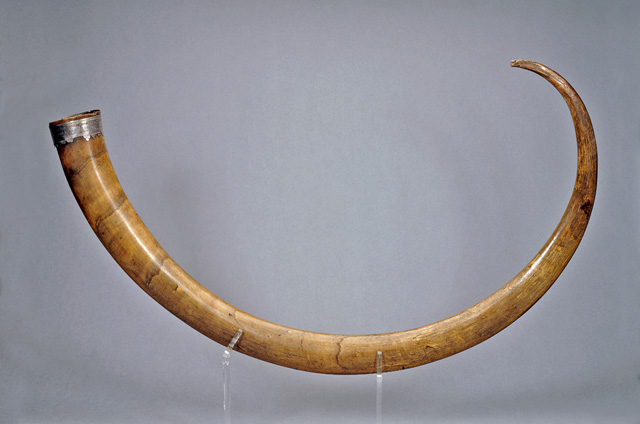"Griffin's Claw" of St. Cuthbert
The British Museum, London
Copyright © The Trustees of the British Museum

 Select the image to zoom
Select the image to zoom
This horn is associated with the popular Anglo-Saxon saint Cuthbert (634–87), who was a hermit and the bishop of Lindisfarne, in the north of England. St. Cuthbert's remains were venerated at Durham Cathedral, where this horn was discovered. Although claimed to be the claw of a griffin, a mythical half-eagle half-lion, it is the horn of an Alpine goat, the ibex. The mount, bearing an inscription, is thought to be of a later date than the horn itself: an inventory of the shrine of St. Cuthbert in Durham Cathedral, compiled in 1383, lists two griffins' claws and griffins' eggs. The claw would have been part of a collection of fantastic objects displayed at the shrine, most likely given as a donation. The griffin was a magical creature in the medieval consciousness; its claws could only be acquired from the beast in return for medicinal aid from a holy person. These items were often associated with powerful or popular figures. Vinycomb, in 1906, noted that Braunschweig Cathedral still held a griffin's claw brought from the Holy Land by Henry the Lion (r. 1129–95).
There is no firm documentary evidence that this is one of the claws described at the shrine of St. Cuthbert in 1383. However, its emergence in the collection of Sir Robert Cotton (1571–1631) in the years after the Reformation might support the suggestion that it was indeed a survival from the despoliation of the shrine. The Cotton Collection was dedicated to the nation by an Act of Parliament in 1701 by Sir John Cotton and formed part of the first collection of the British Museum on its formation in 1753. The three generations of gentlemen collectors in the Cotton family, Sir Robert, Sir Thomas, and Sir John, all reflect the gentlemanly trend for forming "cabinets of curiosities," which became popular from the sixteenth century through much of the eighteenth. This griffin claw may have moved from its venerated position among the wonders of St. Cuthbert's shrine to a gentleman's collection of exotic material. In both positions the claw would have been an object of wonder, drawing pilgrims in a spiritual and secular sense, pre- and post-Reformation.




